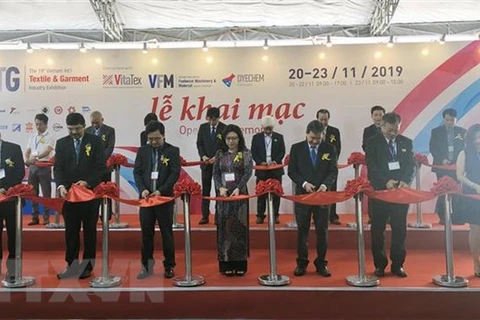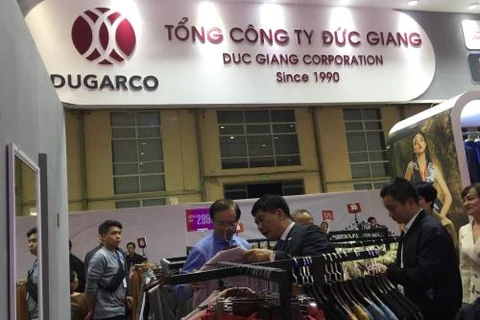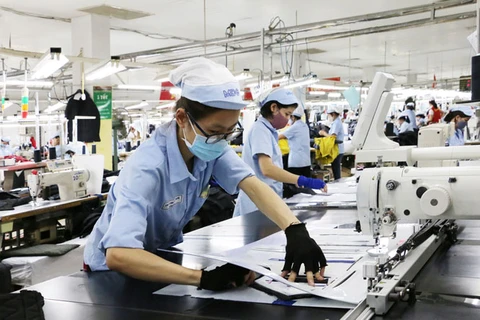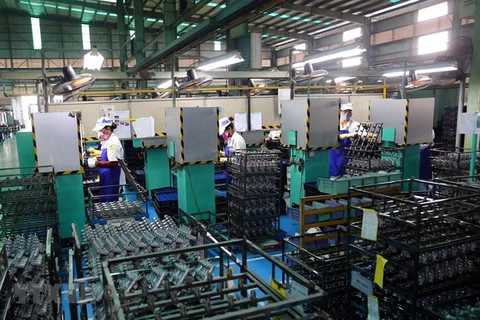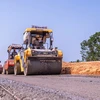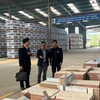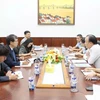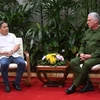Hanoi (VNA) – In 2019, the garment-textile industry imported 22.36 billion USD worth of materials.
The “bottlenecks” in the sector lie in the textile production, dyeing and finishing, according to Deputy Director of the Vietnam Textile and Garment Group (Vinatex) Cao Huu Hieu.
He told reporters from VietnamPlus that since the beginning of this year, the COVID-19 epidemic has spread widely in China and other countries worldwide, making it difficult for many Vietnamese garment-textile firms to import materials for production.
Some bought materials before the traditional Lunar New Year, but the amount was sufficient for production only to the end of March and April, he said.
For signed orders, businesses move to re-negotiate with customers to extend the delivery due to the impact of the epidemic.
 Garment-texile sector applies advanced technologies to increase productivity (Photo: Xuan Quang/VietnamPlus).
Garment-texile sector applies advanced technologies to increase productivity (Photo: Xuan Quang/VietnamPlus).
Given the situation, retailers must take measures such as lowering prices and stimulating local consumption. As a result, many Vietnamese textile firms have faced more difficulties due to falls in demand and orders.
However, in the past two months, Vinatex member businesses have recognised some opportunities in other products such as masks and protective gears, not only serving the domestic market but also for export to foreign ones, Hieu said.
 Vietnamese garment-textile firms boost distribution channels at home (Photo: Xuan Quang/VietnamPlus).
Vietnamese garment-textile firms boost distribution channels at home (Photo: Xuan Quang/VietnamPlus).
Hieu went on to say that the Government has issued Decree 111/2015/ND-CP on developing supporting industry for various sectors. However, there are no specific action programmes to implement that document.
Compared to strong garment-textile exporters like India and Bangladesh, the support for developing specific export policies in Vietnam is still limited, according to Hieu.
Signed new-generation free trade agreements such as the EU-Vietnam Free Trade Agreement (EVFTA), the Comprehensive and Progressive Agreement for Trans-Pacific Partnership (CPTPP), and the EU-Vietnam Investment Protection Agreement (EVIPA) are expected to draw foreign investment to the garment-textile sector.
Hieu noted that from 2013 to 2018, each billion USD of FDI poured into the sector created 10.2 billion USD worth of exports on average. The total registered FDI in the industry in the six-year period hit nearly 9.6 billion USD, surpassing the figure from 1988 to 2012 (8 billion USD).
The FDI sector has made significant contribution to the sector’s exports in the past six years, making up 60 percent of the total.
The compound annual growth rate (CAGR) in 2013-2018 in garment-textile exports of the FDI sector reached 11.75 percent, higher than that of the domestic enterprises in the same period (10.7 percent).
Free trade agreements have brought many investment opportunities for Vietnam. In the first five months of 2019, China registered 1.56 billion USD in foreign investment in Vietnam with 233 projects, including 11 garment-textile ones worth 190.5 million USD, up 4.1 times against the same period last year.
Hieu pointed out that the most serious headache for investors at present is the lack of capital and highly skilled and competitive workers.
The sector has appealed for the development of separate concentrated industrial zones, he said.
Hieu suggested the government put forth specific policies and incentives in land, capital, technology, human resources training, and interests for the garment-textile sector.
Hieu said at present, Vietnam is enjoying excellent chances provided by a number of signed free trade agreements as well as the shift of the investment flow from foreign countries.
In anticipation of a new influx of FDI, local businesses should be proactive in seeking material supply, he suggested./.




